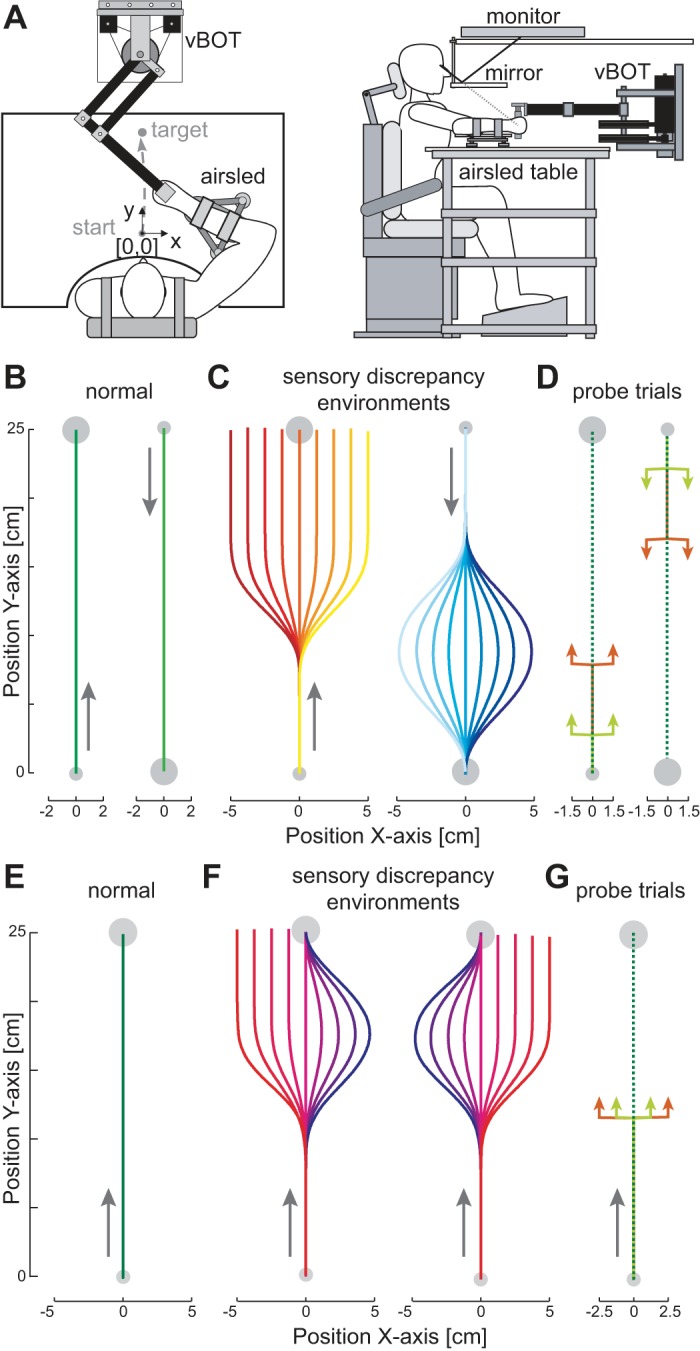Fig. 1.

The experimental setup. A: the subject grasps the robotic manipulandum (vBOT) while seated. Visual feedback is presented veridically with a top-mounted computer screen viewed through a mirror. The subject's forearm is fixed to and supported by an airsled. B: experiment 1: effect of movement direction. Subjects made movements alternately in 2 directions (outward and inward). Initially, movements were performed in the normal condition, where the cursor reproduced the hand trajectory exactly. Note that for clarity of display the outward and inward movements have been horizontally offset in the plots. C: in the second phase of the experiment, the outward movement was performed in the task-relevant environment (red-yellow) whereas the return movements were performed in the task-irrelevant environment (cyan-blue). A second group of subjects performed experiments in which these directions were reversed. In the task-relevant condition, the visual cursor smoothly moved away from the hand trajectory to 1 of 9 amplitudes (including 0) and remained at this point for the rest of the movement. In the task-irrelevant condition, the visual cursor smoothly moved away from the hand trajectory exactly as in the task-relevant condition but then returned smoothly such that it agreed with the physical hand position at the end of the movement. D: the visual perturbations (probe trials) used in experiment 1 to examine the magnitude of the visually induced motor response. On random trials, the hand was mechanically constrained to a straight-line trajectory to the target and the visual cursor representing the hand was jumped laterally away from the actual hand position and returned 250 ms later. Two different onsets of the perturbations (light green and orange arrows) were chosen for each direction: 1 pair (orange) were matched for the spatial location of the visual perturbation of the 2 directions of movement (matched stimuli perturbations: occurring at 30% of the distance to the target), and the other pair (light green) were matched so that the visuomotor response occurred at a similar location for the 2 directions of movement (matched response perturbations: occurring at 10% of the distance to the target). E: experiment 2: effect of perturbation direction. Subjects performed outward reaching movements. Initially, all subjects performed movements in the normal environment. F: in the second half of the experiment 1 group of subject made movements under 1 of the sensory discrepancy environments (left), whereas the other group was presented with the opposite environment (right). In these environments, the visual cursor representing the subject's hand was manipulated in a task-relevant manner on one side of the movement and in a task-irrelevant manner on the other side of the movement. G: the visual perturbations (probe trials) used in experiment 2 to examine the magnitude of the visually induced motor response. Two sizes of perturbation were used on either side of the zero perturbation to examine changes in the gain of the response.
